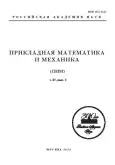Necessary Conditions for Development of Inviscid Instabilities in a Vibrationally Excited Dissociating Gas
- Authors: Grigoryev Y.N.1, Ershov I.V.2
-
Affiliations:
- Federal Research Center for Information and Computational Technologies
- Novosibirsk State Agrarian University
- Issue: Vol 87, No 3 (2023)
- Pages: 409-422
- Section: Articles
- URL: https://journals.rcsi.science/0032-8235/article/view/138867
- DOI: https://doi.org/10.31857/S0032823523030049
- EDN: https://elibrary.ru/ZSWUBU
- ID: 138867
Cite item
Full Text
Abstract
For a plane flow of a vibrationally excited dissociating diatomic gas the necessary conditions of the existence of growing (neutral) inviscid perturbations, similar to the Rayleigh criterion of a “generalized” inflection point, are obtained. The corresponding formulas are presented for cases with a certain physical interpretation. In particular, the model of a vibrationally excited one-component gas is considered as the initial stage of thermal dissociation, as well as a wide spread model with one dissociation-recombination reaction. The case of a binary molecular-atomic mixture with a vibrationally excited molecular component and a “frozen” gas-phase dissociation-recombination reaction is considered as an intermediate one. Comparative numerical calculations were carried out, which showed, in particular, that under conditions of developed dissociation, the use of the criterion of the “generalized” inflection point does not take into account the specifics of the process. The wave numbers and phase velocities of the I and II inviscid modes calculated on its basis may differ significantly from the results obtained using the new necessary condition.
About the authors
Yu. N. Grigoryev
Federal Research Center for Information and Computational Technologies
Author for correspondence.
Email: grigor@ict.nsc.ru
Russia, Novosibirsk
I. V. Ershov
Novosibirsk State Agrarian University
Author for correspondence.
Email: ivershov1969@gmail.com
Russia, Novosibirsk
References
- Lin C.C. The Theory of Hydrodynamics Stability. Cambridge: Univ. Press, 1955. 155 p.
- Drasin P.G., Reid G.H. Hydrodynamic Stability. Cambridge: Univ. Press, 2004. 605 p.
- Lees L. The Stability of the Laminar Boundary Layer in a Compressible Fluid. NACA Technical note, No. 1360. Washington: NACA, 1947. 169 p.
- Mack L.M. Boundary Layer Stability Theory. JPL Technical Rep., Document 900–277. Pasadena: California Instit. Technology, 1969. 272 p.
- Duck P.W., Erlebacher G., Hussaini M.Y. On the linear stability of compressible plane Couette flow // J. Fluid Mech., 1994, vol. 258, pp. 131–165.
- Grigoryev Yu.N., Ershov I.V. The linear stability of inviscid shear flow of vibrationally excited diatomic gas // JAMM, 2011, vol. 75, iss. 4, pp. 410–418.
- Grigor’ev Yu.N., Ershov I.V. Linear stability of the Couette flow of a vibrationally excited gas. 1. Inviscid problem // J. Appl. Mech.&Tech. Phys., 2014, vol. 55, no. 2, pp. 258–269.
- Shen S.F. Effect of chemical reaction on the inviscid criterion for laminar stability of parallel flows // Proc. 5-th Midwest. Conf. Fluid Mech. Ann Arbor., 1957, pp. 11–20.
- Gaponov S.A., Petrov G.V. Stability of the Boundary Layer of a Nonequilibrium Dissociating Gas. Novosibirsk: Nauka, 2013. 95 p. (in Russian)
- Grigoryev Yu.N., Gorobchuk A.G., Ershov I.V. Model of the boundary layer of a vibrationally excited dissociating gas // Thermophys. Aeromech., 2021, vol. 28, no. 5, pp. 635–647.
- Tricomi F. Differential Equations. Blackie & Son Limited, 1961. 326 p.
- Grigor’ev Yu.N., Ershov I.V. Asymptotic theory of neutral stability curve of the Couette flow of a vibrationally excited gas // J. Appl. Mech.&Tech. Phys., 2017, vol. 58, no. 1, pp. 1–16.
- Fikhtengolts G.M. Course of Differential and Integral Calculus. Vol. 1. Moscow: Fizmatlit, 2003. 680 p. (in Russian)
- Loitsyanskii L.G. Mechanics of Liquids and Gases. Oxford: Pergamon, 1966. 804 p.
- Grigor’ev Yu.N., Ershov I.V. Linear stability of the boundary layer of relaxing gas on a plate // Fluid Dyn., 2019, vol. 54, no. 3, pp. 295–307.
Supplementary files










